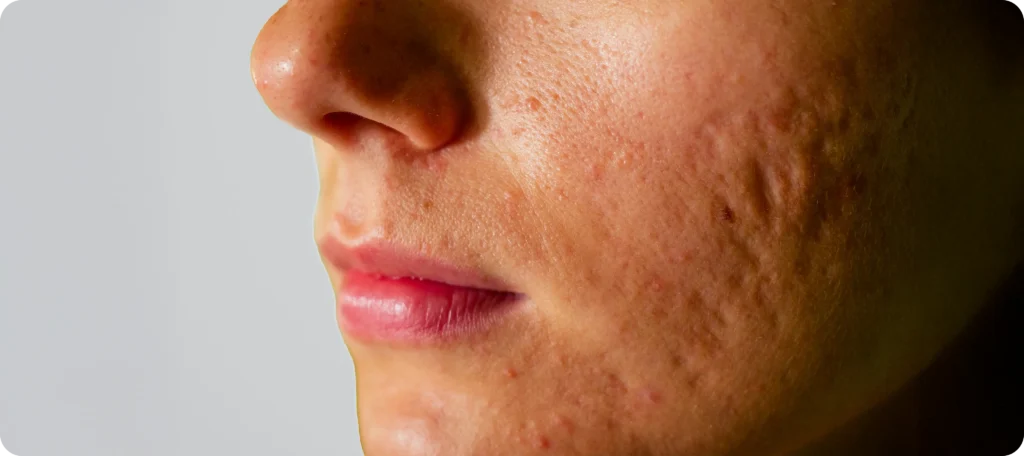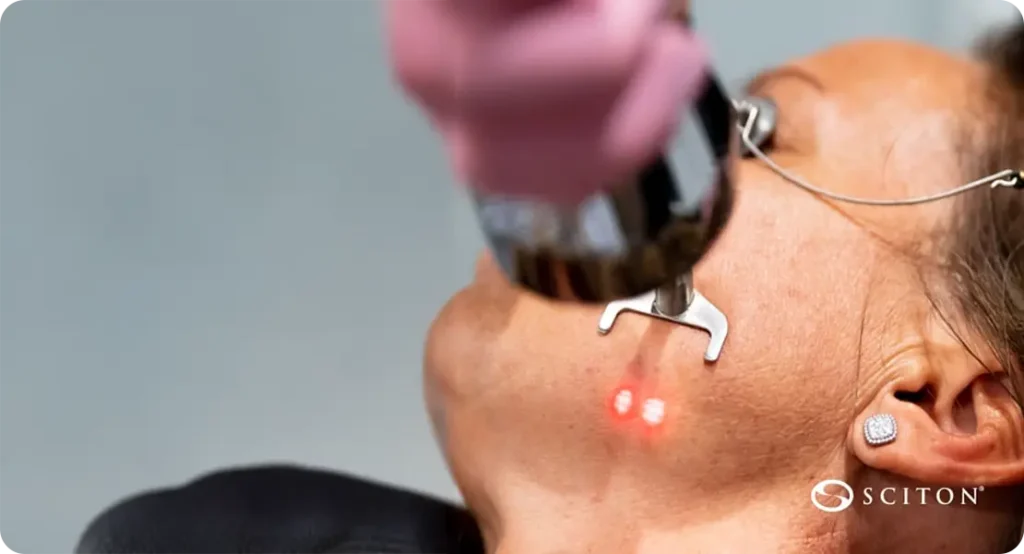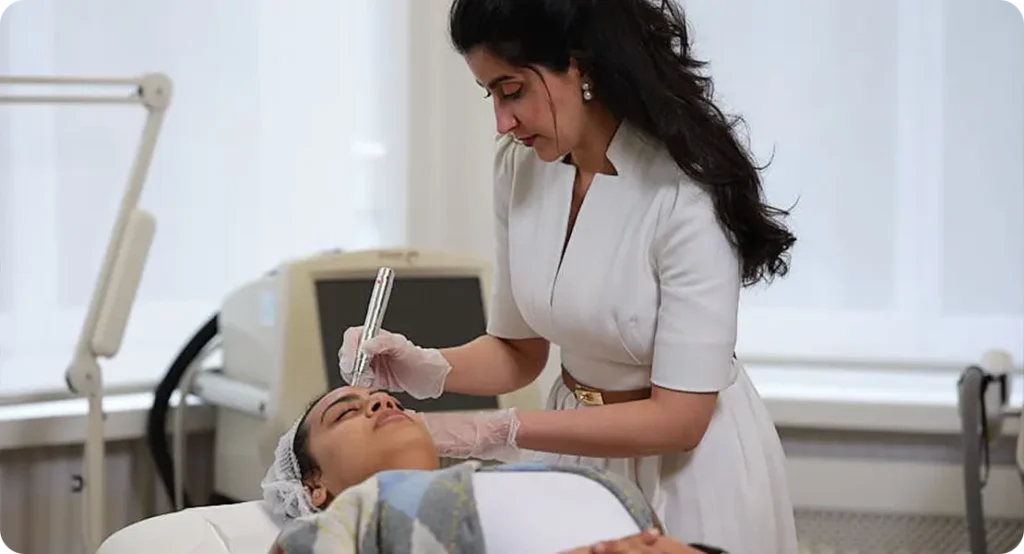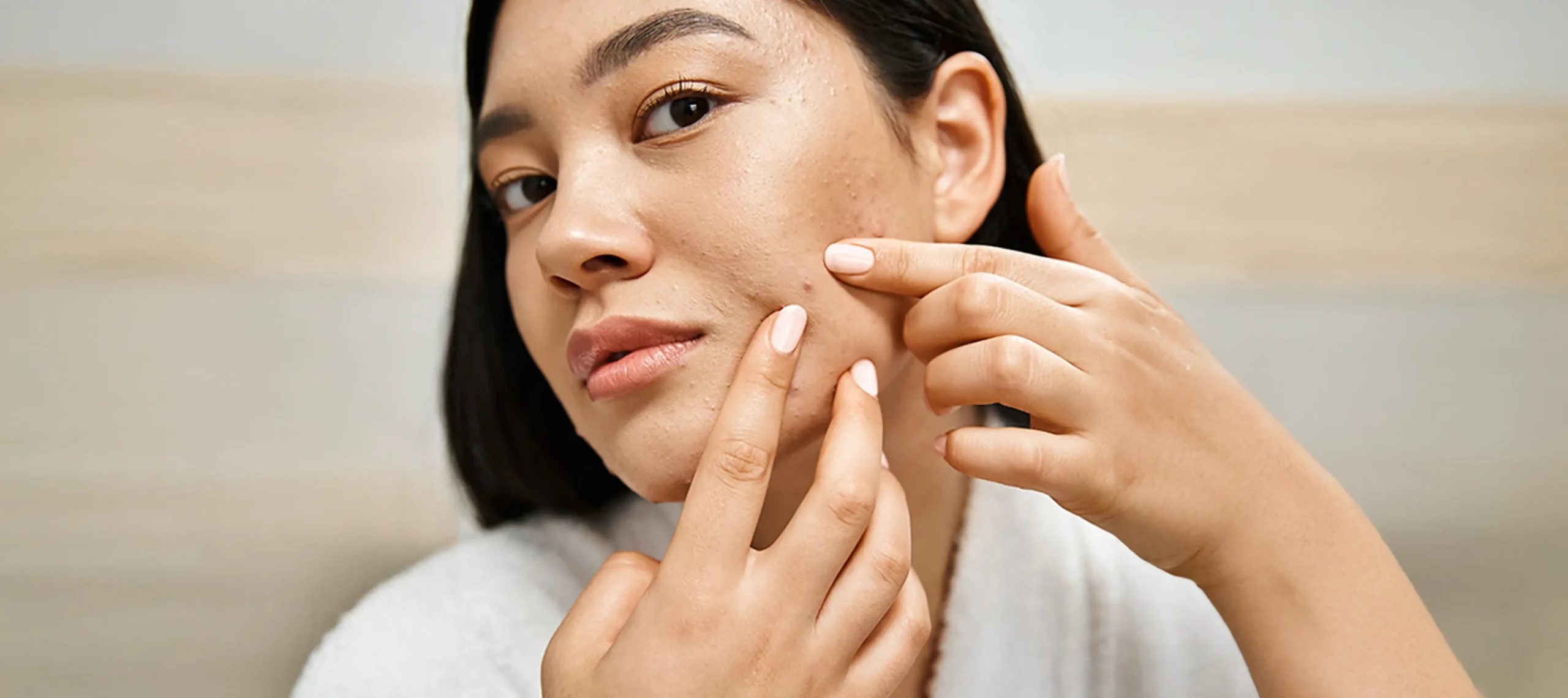Acne scars can be a lasting reminder of past breakouts, affecting the look and feel of your skin. But the good news is that there are ways to reduce their appearance and, in some cases, even get rid of them entirely. Let’s break down what causes acne scars, the different types you might have, and what you can do about them.
What Causes Acne Scarring?
Acne scarring occurs when the skin undergoes an improper healing process following an acne breakout. When acne lesions become inflamed, they disrupt the surrounding skin tissue, sometimes causing deep damage beneath the surface. The body responds by attempting to repair this damage through collagen production. However, if too little collagen is produced, the skin cannot fully restore itself, leading to depressions or indentations. On the other hand, if too much collagen is generated, the skin may form raised scars that extend beyond the original site of inflammation.
The extent of scarring largely depends on the severity of the acne. Mild breakouts may leave behind temporary redness or pigmentation, while more aggressive forms—such as cystic acne—penetrate deep into the skin and are more likely to cause permanent scarring. The longer an acne lesion remains inflamed, the greater the chance of scar tissue forming. This is because prolonged inflammation breaks down skin-supporting structures, making it harder for the body to repair the affected area smoothly.
Genetics also play a role in how prone you are to acne scarring. Some people naturally produce more collagen in response to skin damage, making them more susceptible to raised scars, while others may experience long-lasting indentations due to insufficient collagen production. Skin type and tone can also influence scarring; for instance, individuals with darker skin tones may be more prone to post-inflammatory hyperpigmentation, which can make scars appear more pronounced.
Certain behaviours can further increase the risk of scarring. Picking, squeezing, or scratching at acne disrupts the healing process and forces bacteria deeper into the skin, leading to a more severe inflammatory response. Additionally, failing to properly treat acne at an early stage can result in repeated breakouts in the same areas, increasing the likelihood of lasting damage. Understanding these factors can help in taking preventive measures to minimise scarring and maintain healthier skin.
Types of Acne Scars
Acne scars can be broadly classified into two main categories: depressed (atrophic) scars and raised (hypertrophic or keloid) scars. The type of scarring you develop depends on how your skin heals after an acne breakout. If the skin loses too much collagen during the healing process, it results in depressions or indentations, while excess collagen production can lead to raised scars. Understanding these different types can help in identifying the most suitable treatment approach.
Depressed (Atrophic) Scars
Atrophic scars develop when the skin does not produce enough collagen during the healing phase, leading to a loss of tissue and an uneven skin surface. These scars are more common on the face and can vary in depth and shape.

- Ice Pick Scars: These scars appear as narrow, deep indentations that resemble tiny punctures in the skin, often giving the appearance of small, sharp holes. Ice pick scars occur when an acne lesion extends deep into the skin, damaging the underlying tissue. Because of their depth, these scars can be particularly difficult to treat with surface-level treatments and often require procedures that target deeper layers of the skin, such as laser therapy or punch excision.
- Rolling Scars: Unlike ice pick scars, rolling scars are broader and have sloping, uneven edges. They create a wavy or undulating texture on the skin due to the formation of fibrous bands beneath the surface that pull the skin downward. These scars are often the result of long-term inflammatory acne and tend to be more noticeable when light hits the skin at certain angles. Treatments that help break down the fibrous bands, such as subcision or microneedling, can be effective in improving the appearance of rolling scars.
- Boxcar Scars: These scars are wider than ice pick scars but have more defined, sharper edges. They tend to form when inflammatory acne destroys collagen in a way that leaves distinct depressions in the skin, similar to the marks left by chickenpox. Boxcar scars are typically shallow to moderately deep, and their appearance can often be improved with resurfacing treatments like chemical peels, laser therapy, or dermal fillers to restore volume.
Raised (Hypertrophic & Keloid) Scars
Unlike atrophic scars, raised scars occur when the skin produces excess collagen as it heals. These types of scars are more common on areas of the body with thicker skin, such as the chest, shoulders, and back.
- Hypertrophic Scars: These scars develop within the original boundaries of an acne lesion but appear as thick, raised bumps on the skin. Hypertrophic scars are caused by an overproduction of collagen during the healing process, leading to a dense build-up of tissue. They can sometimes fade over time but may remain raised and noticeable. Treatments such as corticosteroid injections, silicone gel sheets, and laser therapy can help reduce their size and improve their appearance.
- Keloid Scars: Similar to hypertrophic scars, keloids also result from excessive collagen production, but unlike hypertrophic scars, they grow beyond the original site of the acne lesion. Keloid scars tend to be larger, thicker, and can become itchy or even painful. They are more common in individuals with darker skin tones and can continue to expand if left untreated. Keloids are more challenging to treat, but options such as corticosteroid injections, cryotherapy, and laser therapy can help reduce their size and discomfort.
By understanding the different types of acne scars, you can take a more informed approach to treatment and prevention. Whether dealing with atrophic or raised scars, there are various medical and cosmetic procedures available to improve skin texture and restore a smoother, more even appearance.
How Can You Treat Acne Scars?
If you have acne scars that affect your confidence or skin texture, there are several treatment options to help improve their appearance. The best approach depends on the type of scars you have, your skin type, and how well your skin responds to certain treatments. Some treatments focus on resurfacing the skin, while others work beneath the surface to stimulate collagen production or break down scar tissue. Since every person’s skin is different, a consultation with a dermatologist can help determine the most suitable method for your needs.
While some treatments provide gradual improvements over time, others may require multiple sessions for noticeable results. Some procedures have minimal downtime, making them convenient for those with busy schedules, whereas others may require a longer healing period. Understanding the benefits and limitations of each treatment can help you set realistic expectations and choose the best solution for your skin concerns.
Laser Treatments
Laser therapy is one of the most effective methods for treating acne scars because it precisely targets damaged skin without affecting the surrounding tissue. Different types of lasers are used depending on the severity and type of scarring. Ablative lasers work by removing the top layer of skin, promoting the growth of new, smoother skin, while non-ablative lasers stimulate collagen production beneath the skin without removing any layers. Fractional laser therapy is particularly useful for atrophic scars, as it penetrates deeper layers of skin to encourage natural healing.

One of the biggest advantages of laser treatments is their ability to improve both the texture and pigmentation of scars. However, they require multiple sessions for optimal results, and aftercare is essential to protect the skin during the healing process. Since laser therapy can make the skin more sensitive, it’s important to avoid sun exposure and follow post-treatment skincare recommendations. While laser treatments can be highly effective, they may not be suitable for all skin tones, so a professional assessment is necessary before starting treatment.
Chemical Peels
Chemical peels involve applying a specially formulated solution to the skin, which exfoliates the top layer and promotes the regeneration of new, healthy skin cells. This treatment is particularly beneficial for superficial acne scars, as well as for improving overall skin tone and reducing hyperpigmentation. Peels come in different strengths, ranging from mild (superficial peels) to deeper peels that target more pronounced scarring.
Superficial chemical peels require little to no downtime and can be repeated regularly to maintain results, while medium to deep peels involve a longer recovery period. The effectiveness of a chemical peel depends on the depth of the scars, as deeper scars may require multiple treatments or combination therapies for significant improvement. After a peel, the skin may feel sensitive and appear red or flaky as it heals, so proper skincare and sun protection are crucial during the recovery phase.
Microneedling
Microneedling is a minimally invasive treatment that uses a device with fine needles to create controlled micro-injuries in the skin. These tiny punctures stimulate the skin’s natural healing response, encouraging collagen and elastin production. Over time, this helps to smooth out atrophic scars by plumping up the skin and improving its texture. This treatment is suitable for all skin types and tones, making it a versatile option for many people.

The benefits of microneedling go beyond scar reduction; it can also help with fine lines, enlarged pores, and overall skin rejuvenation. While the procedure itself is relatively quick, results develop gradually as the skin produces more collagen. Most people require multiple sessions to achieve the best results, and mild redness or sensitivity is common for a few days post-treatment. To enhance its effectiveness, microneedling is sometimes combined with serums or platelet-rich plasma (PRP) therapy for deeper skin nourishment.
Dermal Fillers
Dermal fillers offer a temporary but effective solution for certain types of atrophic acne scars, particularly boxcar and rolling scars. These injectable treatments work by filling in depressions in the skin, making the surface appear smoother and more even. The most common type of filler used is hyaluronic acid, a substance naturally found in the skin that helps retain moisture and volume.
The effects of dermal fillers are immediate, but they are not permanent. Depending on the type of filler used, results typically last anywhere from six months to a year before additional treatments are needed. While fillers do not permanently alter scar tissue, they can provide a significant confidence boost by instantly improving the appearance of scars. As they wear off gradually, maintenance treatments are required to sustain results.
Subcision
Subcision is a minor surgical procedure designed specifically for treating rolling scars, which are caused by fibrous bands that pull the skin downward. During the procedure, a small needle is inserted beneath the scar to break these bands, allowing the skin to lift and become more even over time. This process triggers collagen production, which further improves the appearance of the scar.
Since subcision directly addresses the underlying cause of rolling scars, it is often used in combination with other treatments such as microneedling or laser therapy for enhanced results. The procedure itself is relatively quick and has minimal downtime, though mild swelling and bruising may occur for a few days. With multiple sessions, subcision can lead to long-term improvements in skin texture and scar reduction.
Steroid Injections
Steroid injections are commonly used to treat raised scars, such as hypertrophic and keloid scars. These scars occur when excess collagen is produced during the healing process, resulting in thick, raised tissue. Corticosteroids are injected directly into the scar to help soften and flatten it over time by reducing inflammation and collagen production.
This treatment is particularly beneficial for large or painful keloid scars that continue to grow beyond the original acne site. Several injections may be needed over a period of weeks or months, depending on the size and severity of the scar. While steroid injections can significantly improve the texture and size of raised scars, they do not work for atrophic scars. After treatment, the skin may appear slightly lighter or thinner in the treated area, so careful monitoring by a dermatologist is essential.
By understanding the various treatment options available, you can make an informed decision about the best approach for your skin. Whether you opt for laser therapy, microneedling, or another method, consulting with a skincare specialist will help you determine the most effective way to achieve smoother, healthier-looking skin.
How Can You Prevent Acne Scars?
While acne scars can be difficult to treat, prevention is always the best approach. Although some people may be more prone to scarring due to genetics or skin type, there are effective steps you can take to minimise the risk of permanent marks. By managing acne properly and being mindful of your skincare habits, you can reduce inflammation, promote faster healing, and prevent unnecessary damage to your skin. The following preventive measures can help you maintain clearer skin and avoid lasting scars.

- Treat acne early – Addressing acne as soon as it appears is one of the most effective ways to prevent scarring. When breakouts linger untreated, they have a higher chance of developing into severe forms like cystic or nodular acne, which can damage deeper layers of skin. Using the right skincare products, over-the-counter treatments, or prescription medication (if necessary) can help control acne before it leads to long-term skin damage. Seeking professional advice from a dermatologist early on can also make a significant difference in reducing the risk of scars.
- Avoid picking or squeezing – One of the most common causes of acne scars is the habit of picking, squeezing, or popping pimples. While it may be tempting to remove a blemish quickly, this action can force bacteria and debris deeper into the skin, leading to more inflammation and damage. When the skin’s healing process is disrupted, it can result in post-inflammatory hyperpigmentation or permanent scarring. Instead of picking at breakouts, allow them to heal naturally and use spot treatments containing ingredients like salicylic acid or benzoyl peroxide to speed up the healing process.
- Wear sunscreen – Sun exposure can worsen the appearance of acne scars by causing pigmentation to darken, making them more noticeable and difficult to fade. UV rays can also slow down the skin’s natural healing process, leading to prolonged redness and uneven skin tone. Applying a broad-spectrum sunscreen with SPF 30 or higher every day—even on cloudy days—can protect the skin from UV damage and help scars fade more quickly. Choosing a lightweight, non-comedogenic sunscreen will ensure that your skin is protected without clogging pores or triggering new breakouts.
- Use gentle skincare – Using harsh or irritating skincare products can aggravate acne-prone skin, leading to increased inflammation and a higher risk of scarring. Opt for non-comedogenic products that are specifically formulated to prevent clogged pores and support the skin’s healing process. A gentle cleanser, hydrating moisturiser, and products with soothing ingredients like niacinamide or aloe vera can help maintain a healthy skin barrier. Avoid excessive scrubbing, strong exfoliants, or alcohol-based toners, as they can strip the skin of its natural oils and lead to irritation, which may slow down the healing process.
By following these preventative steps, you can significantly reduce the likelihood of acne scars and support your skin’s long-term health. Consistency in your skincare routine, sun protection, and early acne management are key factors in maintaining a smoother, more even complexion.
Conclusion
Acne scars can be frustrating, but they don’t have to be permanent. Understanding what type of scars you have and exploring the right treatment options can make a big difference. Whether you choose laser therapy, microneedling, or a simple change in your skincare routine, there are solutions to help improve the look and feel of your skin. If you’re concerned about acne scars and want expert advice on the best treatment for your skin, you can contact us here at the London Dermatology Centre to book a consultation. Our specialist dermatologists can assess your skin and recommend a personalised plan to help you achieve smoother, clearer skin.
